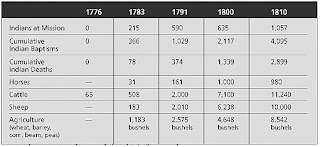 |
| 1939 drawing by Ramos Martinez |
Growing up in California the MISSIONS are a part of our history and local scenery, but I am sure that in other parts of the country this Franciscan friar and his works are not so well known.
BLESSED JUNIPERO SERRA was born Miguel Jose Serra on November 24th, 1713 in Majorca, Spain. He entered the Order of Friars Minor in 1730. Because he was so good with his studies, Bl. Serra was appointed Lector of Philosophy before he was ordained. Later he received his doctorate from Lullian University in Palma De Mallorca.
 |
| Portrait as a young man. |
In 1749, Bl. Junipero traveled to Mexico City. On the way from Vera Cruz to Mexico City, he was bitten in the leg by a snake. The bite never got better, and the leg bothered him for the rest of his life. He never wanted any help with it, preferring to walk whenever he could.
 |
| Plaza, Los Angeles |
From Mexico City, he requested a transfer to the Sierra Gorda Indian Mission. He spent nine years there, learning the language of the Pame Indians, and translating the Catechism into their language. He was soon recalled to Mexico City and gained fame as being the most fervent and most effective preacher, because he would do anything in order to get people to repent.
In 1769 Bl. Junipero accompanied Governor Gaspar de Portola to Nueva California. The expedition landed in San Diego, where Bl. Serra founded Mission San Diego de Alcala, the first of 21 California missions. After founding Mission San Carlos Borromeo de Carmelo in Montery, Bl. Junipero relocated his headquarters to Carmel. Each of the California missions is located within one day’s walk of each other.
His beatification was been delayed for many years as some thought his treatment of the Indians was not fair, or that the peoples under his care were exploited. One only has to look at the history of those times to see problems everywhere, much not of the saint's making. He actually pressed for laws to protect the Natives from the abuses of the military.
In a letter he wrote on 24th August, 1774, Bl.Serra explained that: "Every day Indians are coming in from distant homes in the Sierra... They tell the padres they would like them to come to their territory. They see our church which stands before their eyes so neatly; they see the milpas with corn which are pretty to behold; they see so many children as well as people like themselves going about clothed who sing and eat well and work." Serra wrote that he was especially pleased with the impact the missionaries were having on the children: "The spectacle of seeing about a hundred young children of about the same age praying and answering individually all the questions asked on Christian doctrine, hearing them sing, seeing them going about clothed in cotton and woolen garments, playing happily and who deal with the padres so intimately as if they had always known them."
 |
| Chart showing success at Mission San Francisco |
Around 1778, Bl. Serra was given dispensation to give the sacrament of Confirmation. He went around confirming people for a year until Felipe de Neve told him to stop until he could present a Papal Brief.
Bl. Junipero waited for two years, until the Viceroy Majorga gave instructions to the effect that the saint was within his rights. Over the next three years, he traveled from San Francisco to San Diego, over 600 miles, and confirmed 5,309 people.
 During the American Revolutionary War, Bl. Junipero took up a collection from his mission parishes throughout California. The total money collected amounted to about $137 ( not a small sum in those days) and the money was sent to General George Washington
During the American Revolutionary War, Bl. Junipero took up a collection from his mission parishes throughout California. The total money collected amounted to about $137 ( not a small sum in those days) and the money was sent to General George WashingtonOn August 28, 1784, at the age of 70, Bl. Junípero Serra died at Mission San Carlos Borromeo. He is buried there under the sanctuary floor. He was beatified by Pope John Paul II on September 25th 1988.
The chapel at Mission San Juan Capistrano, built in 1782, is thought to be the oldest standing building in California. Known as "Father Serra's Church," it has the distinction of being the only remaining church in which Father Serra is known to have celebrated the rites of the Roman Catholic Church (he presided over the confirmations of 213 people on October 12 and October 13, 1783). This mission is also the closest to where I grew up so we visited frequently. When I was in High School a "great date" was a ride through the country and a picnic at one of the Missions, Santa Barbara and Santa Inez being favorites.
 |
| San Juan Capistrano |
 |
| Statue at Capistrano |
A statue of Friar Junípero Serra is one of two statues representing the state of California in the National Statuary Hall Collection in the United States Capitol. The statue, sculpted by Ettore Cadorin, depicts Serra holding a cross and looking skyward.
 |
| Ettore Cadorin |
 |


No comments:
Post a Comment